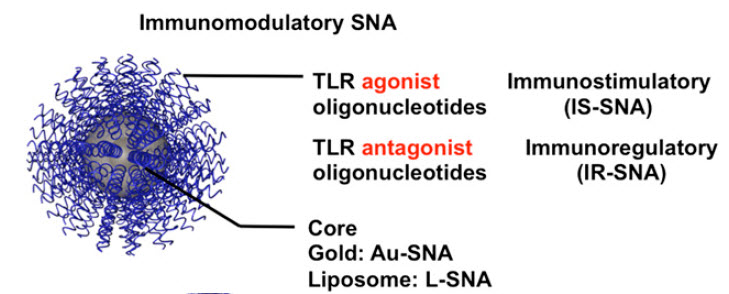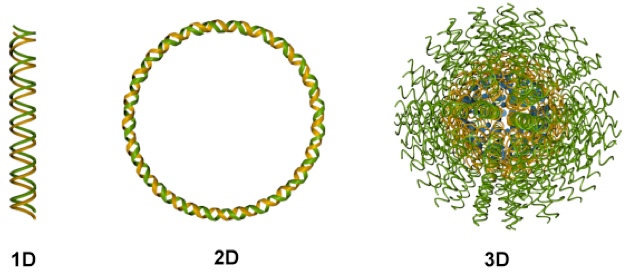Spherical nucleic acids train immune system to fight disease
March 17, 2015

Design and properties of immunomodulatory spherical nucleic acids (credit: Aleksandar F. Radovic-Moreno et al./PNAS)
A research team led by Northwestern University nanomedicine expert Chad A. Mirkin and Sergei Gryaznov of AuraSense Therapeutics has shown that spherical nucleic acids (SNAs) can be used as potent drugs to effectively train the immune system to fight disease, by either boosting or dampening the immune response. The initial treatment triggers a cell-specific immune response all over the body.
By increasing the body’s immune response toward a specific cell type, SNAs could be used to target anything from influenza to different forms of cancer. They also can be used to suppress the immune response, a tactic important in treating autoimmune disorders, such as rheumatoid arthritis and psoriasis, where the body’s immune system mistakenly attacks healthy tissues.
“The ability to selectively trigger the immune response with spherical nucleic acids presents a whole new way of thinking about drug development,” said Mirkin, a corresponding author of the study. “Once developed fully, SNAs will lay the foundation for developing an entire new pipeline of drugs to treat a range of diseases, from psoriasis, lupus and rheumatoid arthritis to lymphoma, bladder cancer and prostate cancer.”

Three important classes of nucleic acids (credit Joshua I. Cutler/Creative Commons)
The study also shows that a spherical structure is the ideal architecture for delivering nucleic acids into cells for therapeutic purposes. The spherical arrangement of approximately 100 DNA strands attached to a benign nanoparticle core made of lipid or gold significantly outperformed nucleic acids in linear form.
SNAs offer several advantages in targeting the immune system: They are nontoxic, go to the right place in cells (via the endosome, a compartment where the immune system’s toll-like receptors (TLRs) are located), are very potent, and the single-stranded DNA on the nanoparticle core can be ideally positioned and oriented to specifically and fully interact with the targeted toll-like receptors. (Linear nucleic acids are delivered in random form and, therefore, do not engage the TLRs as effectively.)
In a study of mice, the researchers tested SNAs against lymphoma. For the animals treated with SNAs, the researchers found a significant decrease in tumor growth and a doubling of lifespan. The potency was up to an 80-fold increase over linear nucleic acids of the same sequence. In this case, SNAs trained the immune system to seek out and destroy lymphoma cells.
Next, focusing on nonalcoholic steatohepatitis (NASH), the researchers found eightfold increases in potency when animals were treated with SNAs and a 30 percent greater reduction in the animals’ fibrosis score. This observation has significant implications for treating liver cancer and cirrhosis patients.
“The beauty of the approach is that a very small amount of drug does a tremendous amount of work,” Mirkin said. “The SNAs trigger the immune response and, without more drug, additional cells are trained to behave the same way as the initial cells. This gives you a catalytic effect that grows into a systemic search for cells that look, for example, like lymphoma cells.”
Mirkin invented SNAs, new spherical forms of DNA and RNA, at Northwestern in 1996. SNAs are nontoxic to humans, making them a versatile tool in medicine.
Mirkin is the George B. Rathmann Professor of Chemistry in the Weinberg College of Arts and Sciences and professor of medicine, chemical and biological engineering, biomedical engineering and materials science and engineering.
The study will be published this week by the Proceedings of the National Academy of Sciences (PNAS). The National Institutes of Health and DARPA supported the research.
Abstract of Immunomodulatory spherical nucleic acids
Immunomodulatory nucleic acids have extraordinary promise for treating disease, yet clinical progress has been limited by a lack of tools to safely increase activity in patients. Immunomodulatory nucleic acids act by agonizing or antagonizing endosomal toll-like receptors (TLR3, TLR7/8, and TLR9), proteins involved in innate immune signaling. Immunomodulatory spherical nucleic acids (SNAs) that stimulate (immunostimulatory, IS-SNA) or regulate (immunoregulatory, IR-SNA) immunity by engaging TLRs have been designed, synthesized, and characterized. Compared with free oligonucleotides, IS-SNAs exhibit up to 80-fold increases in potency, 700-fold higher antibody titers, 400-fold higher cellular responses to a model antigen, and improved treatment of mice with lymphomas. IR-SNAs exhibit up to eightfold increases in potency and 30% greater reduction in fibrosis score in mice with nonalcoholic steatohepatitis (NASH). Given the clinical potential of SNAs due to their potency, defined chemical nature, and good tolerability, SNAs are attractive new modalities for developing immunotherapies.